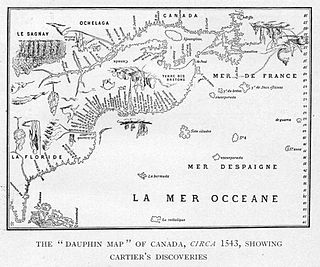| |||||
| Decades: | |||||
|---|---|---|---|---|---|
| See also: | Other events of 1557 History of France • Timeline • Years | ||||
Events from the year 1557 in France
| |||||
| Decades: | |||||
|---|---|---|---|---|---|
| See also: | Other events of 1557 History of France • Timeline • Years | ||||
Events from the year 1557 in France


Jacques Cartier was a French-Breton maritime explorer for France. Jacques Cartier was the first European to describe and map the Gulf of Saint Lawrence and the shores of the Saint Lawrence River, which he named "The Country of Canadas" after the Iroquoian names for the two big settlements he saw at Stadacona and at Hochelaga.

Saint-Malo is a historic French port in Ille-et-Vilaine, Brittany, on the English Channel coast.
This article contains information about the literary events and publications of 1609.

The 16th century in Canada saw the first contacts, since the Norsemen 500 years earlier, between the indigenous peoples in Canada living near the Atlantic coast and European fishermen, whalers, traders, and explorers.

While a variety of theories have been postulated for the name of Canada, its origin is now accepted as coming from the St. Lawrence Iroquoian word kanata, meaning 'village' or 'settlement'. In 1535, indigenous inhabitants of the present-day Quebec City region used the word to direct French explorer Jacques Cartier to the village of Stadacona. Cartier later used the word Canada to refer not only to that particular village but to the entire area subject to Donnacona ; by 1545, European books and maps had begun referring to this small region along the Saint Lawrence River as Canada.
Chief Henri Membertou was the sakmow of the Mi'kmaq First Nations tribe situated near Port Royal, site of the first French settlement in Acadia, present-day Nova Scotia, Canada. Originally sakmow of the Kespukwitk district, he was appointed as Grand Chief by the sakmowk of the other six districts. Membertou claimed to have been a grown man when he first met Jacques Cartier, which makes it likely that he was born in the early years of the sixteenth century.

Jean Le Veneur, son of a Norman baron, was a French Abbot, Bishop, Courtier, royal official, and Roman Catholic cardinal.
Jacques-Théodule Cartier was a French jeweler and Cartier jewelry company executive.

The Centre-Sud is a neighbourhood located in the easternmost edge of the Ville-Marie borough of the city of Montreal.
Events from the year 1627 in France
Events from the year 1755 in France
Events from the year 1719 in France
Events from the year 1491 in France
Events from the year 1625 in France
Events from the year 1535 in France
Events from the year 1630 in France
Events from the year 1547 in France
Humanist Photography, also known as the School of Humanist Photography, manifests the Enlightenment philosophical system in social documentary practice based on a perception of social change. It emerged in the mid-twentieth-century and is associated most strongly with Europe, particularly France, where the upheavals of the two world wars originated, though it was a worldwide movement. It can be distinguished from photojournalism, with which it forms a sub-class of reportage, as it is concerned more broadly with everyday human experience, to witness mannerisms and customs, than with newsworthy events, though practitioners are conscious of conveying particular conditions and social trends, often, but not exclusively, concentrating on the underclasses or those disadvantaged by conflict, economic hardship or prejudice. Humanist photography "affirms the idea of a universal underlying human nature". Jean Claude Gautrand describes humanist photography as:
a lyrical trend, warm, fervent, and responsive to the sufferings of humanity [which] began to assert itself during the 1950s in Europe, particularly in France ... photographers dreamed of a world of mutual succour and compassion, encapsulated ideally in a solicitous vision.

Events from the year 1558 in France